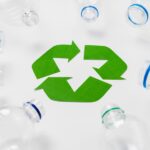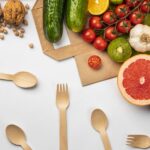Plastic pollution is one of the most pressing environmental challenges of our time. While traditional recycling methods struggle to keep pace with the growing deluge of plastic waste, nature may offer unexpected allies: insects capable of consuming and degrading plastics. These “plastivores” not only digest plastics but also hold potential keys to sustainable waste management.

1. Yellow Mealworm (Tenebrio molitor)
A study published in Insects suggests that T. molitor larvae have demonstrated the ability to consume various plastics, including polystyrene (PS), polyethylene (PE), polypropylene (PP), polyvinyl chloride (PVC), polylactic acid (PLA), and even polyurethane (PU).
This remarkable ability isn’t solely due to the mealworm itself but largely thanks to the diverse community of bacteria residing in its gut. These microbes break down complex plastic polymers into simpler compounds that the mealworm can then utilize for energy. For instance, bacteria like Exiguobacterium and Citrobacter have been identified as key players in degrading PS and PE.
Research has shown that mealworms fed solely on PS can consume about 2.4 milligrams per gram of body weight each day. Interestingly, when their diet is supplemented with bran, a common agricultural byproduct, this rate nearly doubles to 4.1 mg/g/day. This suggests that a balanced diet not only supports the mealworm’s health but also enhances its plastic-degrading efficiency.
Moreover, mealworms can complete their entire life cycle—larva to beetle—while consuming plastic, especially when their diet includes nutritional supplements like bran. This resilience indicates potential for sustainable plastic waste management strategies.
While this doesn’t mean we should start feeding all our plastic waste to mealworms, understanding their unique capabilities offers valuable insights. Harnessing such natural processes could pave the way for innovative solutions to our growing plastic pollution problem.

2. Superworm (Zophobas morio)
Z. morio larvae, commonly known as superworms, have shown a remarkable capacity to digest polystyrene, the tough plastic found in packaging and disposable cups.
In a study from the University of Queensland, researchers fed superworms only polystyrene for three weeks. Not only did the worms survive, but they also gained a bit of weight and completed their life cycle, transforming into beetles. This suggests that superworms can extract energy from plastic alone.
What makes this possible is the unique community of microbes in their guts. These bacteria break down long chains of polystyrene into smaller, manageable compounds. Scientists have identified several bacteria, including Pseudomonas aeruginosa and species from the Rhodococcus and Corynebacterium groups, that produce enzymes capable of degrading polystyrene.
Superworms are particularly efficient at this. They consume polystyrene at a rate of about 0.58 milligrams per day per larva—four times faster than the common mealworm, Tenebrio molitor. This efficiency makes them promising candidates for tackling plastic waste.
However, a diet of only plastic isn’t ideal for their health. Worms fed solely on polystyrene showed reduced microbial diversity in their guts and potential health issues. Combining plastic with food waste could improve their well-being and enhance degradation efficiency.
The ultimate goal isn’t to have swarms of worms eating our trash but to harness the enzymes they use. By understanding and replicating these natural processes, we could develop new methods to recycle and upcycle plastic waste, turning a significant environmental problem into a sustainable solution.

3. Lesser Mealworm (Alphitobius diaperinus)
Native to Africa, A. diaperinus larvae, commonly found in poultry farms, have been observed consuming polystyrene. Research conducted by the International Centre of Insect Physiology and Ecology (icipe) revealed that when these larvae consume polystyrene, their gut bacteria produce enzymes capable of breaking down the plastic into simpler compounds. In controlled experiments, mealworms fed a diet combining polystyrene and bran consumed the plastic more efficiently and exhibited higher survival rates than those fed polystyrene alone. Specifically, they managed to break down approximately 11.7% of the polystyrene over a month-long period.
Further analysis of the larvae’s gut microbiota identified specific bacterial strains, including Kluyvera, Lactococcus, and Klebsiella, which are known to produce enzymes that can degrade synthetic plastics . The presence of these bacteria suggests a symbiotic relationship where the microbes aid in digesting the plastic, providing energy for the larvae while breaking down harmful pollutants.
Dr. Fathiya Khamis, a senior scientist at icipe, emphasized the potential of this discovery, stating that understanding these natural “plastic-eaters” could lead to innovative tools for more efficient plastic waste management. Rather than releasing large numbers of insects into the environment, researchers aim to isolate the responsible enzymes and bacteria to develop microbial solutions that can be applied in waste treatment facilities.
4. Greater Wax Moth (Galleria mellonella)
G. mellonella larvae, known as waxworms, can biodegrade polyethylene plastic bags. This discovery came about quite by accident. Dr. Federica Bertocchini, a molecular biologist and beekeeper, noticed that waxworms she had placed in a plastic bag had chewed holes through it. Intrigued, she and her team at Spain’s Centro de Investigaciones Biológicas Margarita Salas decided to investigate further. They found that the waxworms’ saliva contains two enzymes capable of oxidizing and depolymerizing polyethylene at room temperature within hours—a process that typically requires high temperatures or prolonged exposure to sunlight.
In laboratory experiments, about 100 waxworms consumed nearly 0.1 grams of polyethylene in just 12 hours, a rate surpassing previously known bacteria-based methods. This rapid degradation is significant because polyethylene accounts for a substantial portion of global plastic waste.
The enzymes identified belong to the phenol oxidase family and are the first known animal enzymes to effectively degrade polyethylene without prior treatment. This opens up exciting possibilities for developing bio-based solutions to manage plastic waste more efficiently.

5. Rice Moth (Corcyra cephalonica)
In a study conducted by researchers at Karnatak University, India, rice moth larvae were exposed to low-density polyethylene (LDPE) films to assess their biodegradation capabilities. Over a 20-day period, larvae without antibiotic treatment caused a 25% weight loss in the LDPE films, while those treated with antibiotics achieved a 21% reduction. This suggests that both the larvae’s gut microorganisms and their digestive enzymes contribute to the degradation process.
The findings indicate that C. cephalonica larvae can break down LDPE, a common plastic used in packaging. The study’s results highlight the potential of utilizing such insects in managing plastic waste, especially considering the significant reduction in plastic weight observed during the experiments.
While this research is promising, it’s essential to note that these findings are based on controlled laboratory conditions. Further studies are necessary to understand the full potential and practical applications of using rice moth larvae in large-scale plastic waste management.

6. Dubia Cockroach (Blaptica dubia)
In a 2024 study published in the Journal of Hazardous Materials, researchers discovered that B. dubia cockroaches could digest up to 46.6% of ingested polystyrene within just 24 hours. This rapid breakdown was confirmed through various scientific methods, including isotopic analysis and molecular weight reduction of the plastic residues.
The secret lies in the cockroach’s gut, where a dynamic community of microorganisms collaborates with the host’s own enzymes to tackle the plastic. When fed polystyrene, the gut microbiome shifts, increasing the abundance of plastic-degrading bacteria. This synergy between the insect and its microbes enhances the breakdown process, making B. dubia an efficient degrader of various polystyrene types, from low to ultra-high molecular weights.
Of course, we’re still in the early stages of understanding and applying these findings. Further research is needed to explore how we can safely and effectively integrate such biological solutions into our waste management systems. But the potential is there, and it’s a reminder that sometimes, nature holds the keys to solving the problems we’ve created.

Challenges and Limitations
- Scalability: Currently, most insect-based plastic degradation systems are confined to laboratory or pilot-scale projects. Scaling these systems to handle the vast amounts of plastic waste generated globally presents significant logistical and technical hurdles. Factors such as maintaining optimal conditions for insect survival and ensuring consistent degradation rates need to be addressed before large-scale implementation can be considered.
- Byproducts: While insects can break down certain plastics, the degradation process may produce byproducts that are still environmentally harmful. For instance, the breakdown of polystyrene by insects can result in the release of microplastics or other compounds that may persist in the environment and pose risks to ecosystems and human health.
- Welfare and Ethics: The mass-rearing of insects for plastic degradation raises ethical and ecological questions. Concerns about the welfare of farmed insects, including their living conditions and humane treatment, are gaining attention. Additionally, large-scale insect farming could have unforeseen ecological impacts, such as the potential for invasive species or the spread of diseases.
- Legal Frameworks: There is currently no comprehensive international regulation governing the use of insects for plastic biodegradation. This lack of clear legal guidelines can hinder the development and deployment of insect-based solutions, as regulatory uncertainty may deter investment and innovation in this area.
What Can You Do? Actionable Advice
1. Support Research
Advancing insect-based plastic degradation requires robust scientific research. Institutions like the International Centre of Insect Physiology and Ecology (ICIPE) in Kenya are at the forefront of this field, exploring sustainable methods to manage plastic waste through insect activity. Supporting such organizations through donations or advocacy can accelerate the development of practical applications.
2. Experiment at Home
For educators, students, or hobbyists, conducting a mealworm experiment can be both educational and impactful. By setting up a controlled experiment, you can observe this process firsthand, contributing to a broader understanding of biological plastic degradation.
3. Reduce and Reuse First
While the potential of insects in managing plastic waste is promising, it’s not a standalone solution. The most effective way to combat plastic pollution remains reducing our reliance on single-use plastics and reusing materials whenever possible. Insect-based solutions should complement, not replace, these fundamental practices.
4. Push for Policy
Advocating for environmental policies that incorporate biological solutions to plastic waste is crucial. Engaging with policymakers, participating in public consultations, and supporting legislation that funds research into sustainable waste management can drive systemic change. Your voice can influence the integration of innovative methods, like insect-based degradation, into national and international waste management strategies.
Learn More: Plastic-Eating Fungi: Nature’s Solution to Plastic Pollution
Conclusion:
The discovery of plastic-degrading insects offers promising avenues for addressing the global plastic pollution crisis. By understanding and harnessing the mechanisms these insects use to break down plastics, scientists aim to develop sustainable and efficient methods for managing plastic waste.
However, challenges remain in scaling these biological solutions for industrial use. Future research should focus on isolating and mass-producing the enzymes responsible for plastic degradation, as well as exploring the potential of genetically engineering microbes with enhanced degradative capabilities.
By integrating these natural processes into our waste management systems, we can move towards a more sustainable and environmentally friendly future.







